Gateway FPD2485W: 24" LCD Beauty or Beast?
by Jarred Walton on February 22, 2007 10:00 AM EST- Posted in
- Displays
Features and Appearance
We've already covered some of the features on the specifications page, but we're going to take a closer look at the display here and provide images from various angles. Assembling the display is extremely simple: after removing the three major pieces from the box (the display as well as the two parts of the base stand), you first attach the circular base to the mounting arm and lock it into place using the provided screw on the bottom of the stand. After that all you have to do is insert the top of the LCD mounting mechanism into the stand and then lower it until it snaps into place.
The base stand provides five inches of vertical travel, which gives you a reasonable amount of height adjustment. The stand also allows you to rotate the LCD and use it in portrait mode. While we can't say using a 24" LCD in portrait mode is something we found to be particularly useful, some people might feel otherwise. One of the great things about having such a large LCD is that it gives you the ability to view two documents (or document pages, web pages, etc.) side-by-side with room to spare, making portrait mode largely unnecessary.
With the display in portrait mode, you don't get quite as much vertical travel, and cable routing can be a bit trickier as well. The display supports auto rotate functionality, so as soon as you rotate the display Windows will automatically recognize the new orientation and change your resolution as appropriate. It is unlikely that this functionality works outside of Windows, due to a lack of native drivers for other operating systems, but we did not actually test this functionality outside of Windows; regardless, as stated already we don't find portrait mode to be particularly necessary on widescreen displays.
Here you can see a shot of the display with the optional speaker bar installed. The speaker bar attaches to the bottom of the LCD and receives power via a short cable that connects to the rear of the main display. The speakers only support stereo audio inputs (standard 1/8" DIN or RCA jacks), but they can try to emulate 3D surround sound if you'd like and the overall quality is pretty good given their size. There are plenty of better sounding speaker options available for $70 or less, but one nice benefit of the attached speaker bar is that you get reasonable quality audio without taking up much desk space. If you're more concerned with eliminating cable clutter than with getting premium quality audio, we would definitely add the speaker bar to a purchase of this display. The speakers also have the potential disadvantage of making portrait mode more difficult to access, so if you do intend to use the portrait mode we would forgo purchasing the speaker attachment.
Here you can see the rear of the unit, with or without the speaker bar. The back of the base stand also includes a small ring that can be used to aid in cable routing. If you would rather do without the base stand, you can of course remove the mounting bracket and use a standard VESA wall mount instead.
All of the input ports are located on the back of the unit, facing downward. One of the advantages of being able to rotate the display is that it makes it easier to install the cables initially. The only ports not located on the bottom of the display are two additional USB ports which are located on the left side. The ability to have the display function as a USB hub can be useful, although personally we prefer the integrated flash memory readers found on competing Dell LCDs. Flash memory readers are cheap, but integrating them into the display is one more way of eliminating cable clutter. If you have a flash reader integrated into your PC, of course, having a second reader on your display is largely superfluous.
We've already covered some of the features on the specifications page, but we're going to take a closer look at the display here and provide images from various angles. Assembling the display is extremely simple: after removing the three major pieces from the box (the display as well as the two parts of the base stand), you first attach the circular base to the mounting arm and lock it into place using the provided screw on the bottom of the stand. After that all you have to do is insert the top of the LCD mounting mechanism into the stand and then lower it until it snaps into place.
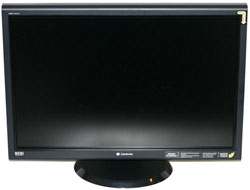 |
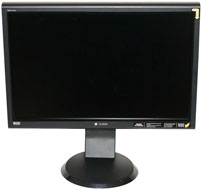 |
| Click to enlarge | |
The base stand provides five inches of vertical travel, which gives you a reasonable amount of height adjustment. The stand also allows you to rotate the LCD and use it in portrait mode. While we can't say using a 24" LCD in portrait mode is something we found to be particularly useful, some people might feel otherwise. One of the great things about having such a large LCD is that it gives you the ability to view two documents (or document pages, web pages, etc.) side-by-side with room to spare, making portrait mode largely unnecessary.
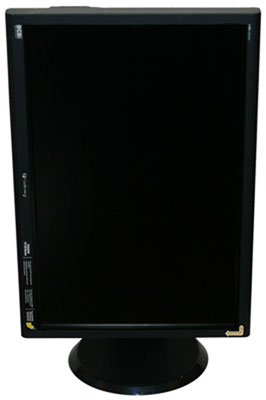 |
| Click to enlarge |
With the display in portrait mode, you don't get quite as much vertical travel, and cable routing can be a bit trickier as well. The display supports auto rotate functionality, so as soon as you rotate the display Windows will automatically recognize the new orientation and change your resolution as appropriate. It is unlikely that this functionality works outside of Windows, due to a lack of native drivers for other operating systems, but we did not actually test this functionality outside of Windows; regardless, as stated already we don't find portrait mode to be particularly necessary on widescreen displays.
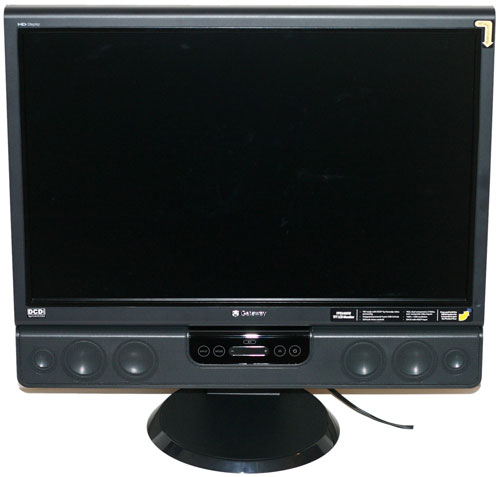 |
| Click to enlarge |
Here you can see a shot of the display with the optional speaker bar installed. The speaker bar attaches to the bottom of the LCD and receives power via a short cable that connects to the rear of the main display. The speakers only support stereo audio inputs (standard 1/8" DIN or RCA jacks), but they can try to emulate 3D surround sound if you'd like and the overall quality is pretty good given their size. There are plenty of better sounding speaker options available for $70 or less, but one nice benefit of the attached speaker bar is that you get reasonable quality audio without taking up much desk space. If you're more concerned with eliminating cable clutter than with getting premium quality audio, we would definitely add the speaker bar to a purchase of this display. The speakers also have the potential disadvantage of making portrait mode more difficult to access, so if you do intend to use the portrait mode we would forgo purchasing the speaker attachment.
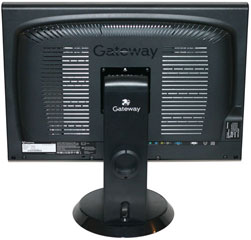 |
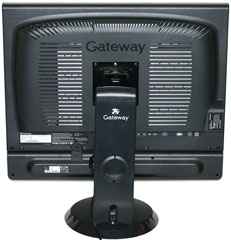 |
| Click to enlarge | |
Here you can see the rear of the unit, with or without the speaker bar. The back of the base stand also includes a small ring that can be used to aid in cable routing. If you would rather do without the base stand, you can of course remove the mounting bracket and use a standard VESA wall mount instead.
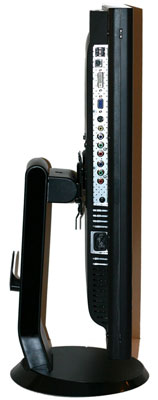 |
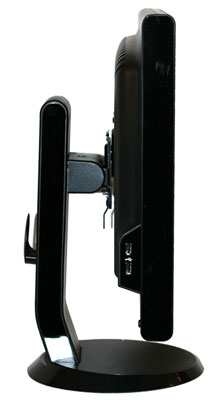 |
| Click to enlarge | |
All of the input ports are located on the back of the unit, facing downward. One of the advantages of being able to rotate the display is that it makes it easier to install the cables initially. The only ports not located on the bottom of the display are two additional USB ports which are located on the left side. The ability to have the display function as a USB hub can be useful, although personally we prefer the integrated flash memory readers found on competing Dell LCDs. Flash memory readers are cheap, but integrating them into the display is one more way of eliminating cable clutter. If you have a flash reader integrated into your PC, of course, having a second reader on your display is largely superfluous.










77 Comments
View All Comments
Justin Case - Thursday, February 22, 2007 - link
As you say, the problem isn't so much the LCDs themselves (with reaction times of 10ms and below, they can do 100 fps), it's the DVI interface. Not because it's digital, just because it's (relatively) slow.The "reaction time" of a CRT isn't zero (unlike what some LCD vendors and tons of clueless retailers claim); in fact, a white-to-black transition takes longer on CRTs than it does on most LCDs. So all this obsession with reaction times ends up hurting consumers, that treat that number as a magical definition of a panel's quality, and completely ignore other (far more relevant) aspects, such as the actual number of displayable colors (without dithering or flipping), color variation with viewing angle, luminance uniformity, etc.
To quote an engineer working for a major (high-end) LCD manufacturer: LCDs are still 2-3 years away from catching up with top CRTs in terms of color reproduction. But when 90% of people can't even tell the difference between a 6-bit panel and an 8-bit one, I wonder what incentive the manufacturers have to improve that...
yyrkoon - Friday, February 23, 2007 - link
If we're talking about ghosting / screen lag, I use a 8ms 19" widescreen LCD, and see none. The only real problem I have, is when I'm playing a graphics intensive game, at the monitors native resolution, and my video card ( 7600GT) can not keep up.This is not to say, that some 'lag' does not exist, but in my case, it is not percievable.
Justin Case - Friday, February 23, 2007 - link
Lag is not the same as ghosting. Lag refers to the fact that the frame you are seeing on screen is not the last frame your graphics card rendered. Some flat panels display the image with a delay of 1 or even 2 frames. This is fine for LCD TV sets (as long as the audio is also delayed, by the same amount), but in interactive applications like games it can be a killer.yyrkoon - Friday, February 23, 2007 - link
As I said above, I see none, and seriously, I play Oblivion, F.E.A.R., not to mention a multitude of other games ;)StevenG - Thursday, February 22, 2007 - link
The game I play doesn't support 1280x960 so I play at 1280x1024. Sure there's some distortion, but it doesn't bother me. And the higher res looks much better than 1024x768 (the next lowest supported resolution in the game).Aquila76 - Thursday, February 22, 2007 - link
This is by far one of the worst LCD's for color accuracy, IMO. I bought one at Best Buy a couple weeks ago, and no matter what settings I used, gradients did not look fully smooth. It is what is refered to as a 'gradation' not a banding.Check here for more info: http://lcdresource.com/index.php?option=com_conten...">Gradation v. Banding
Check here for a test: http://lcdresource.com/index.php?option=com_conten...">Gradient Downloads
What's really sad is that the HP L1706 I use at work (came bundled with the PC) does the gradients flawlessly. A $150 display outperforms this $650 one. I noticed this in games and movies a lot, especially when in a dark place, looking at the sky, etc. I ended up returning mine and am waiting for the NEC 24WMGX3 to come out. I loved the size/resolution for my desktop workspace, but the rest was too much for me to stand.
demani - Monday, April 16, 2007 - link
I wish I had seen this review and comments before I bought mine- The gradient thing is horrible. I am trying to see if I can return mine it is so bad. I haven't seen a panel have that much of an issue with gradients in years-and it ruins what would otherwise be a great panel.If only the Dell could dimmed to regular brightness...
Bastiches.
JarredWalton - Thursday, February 22, 2007 - link
Yikes! Glad someone pointed this out. Some things slip through the cracks when you're trying to come up with a good set of display evaluation tools. I had intended to check color gradients but forgot to actually do it. Ummmm... wow. The Gateway FPD2485W is definitely inferior to competing LCDs in this respect. I will try to get a good picture of the result, but have been unable to do so at present. Regardless, there is definitely a lot of banding visible, something that I didn't see at all in a quick test of a Dell 2407WFP. My 2405FPW shows a slight amount of banding, but not as much as the Gateway.To be honest, this isn't something that was really a problem for me during actual use, but that's likely because I don't do a whole lot of gradient work on a day to day basis. I have updated the text accordingly on pages 8 and 9. Thanks, and I will definitely remember to run this sort of test future display reviews!
mcfraggel - Thursday, February 22, 2007 - link
Input lag is a concern for 24" displays and larger. Some displays have more than 50ms delay. Google for it and you'll find quite a lot about it. Shouldn't this be adressed in this review somewhere?Aquila76 - Thursday, February 22, 2007 - link
I didn't notice any input lag. I had my old CRT side by side for a bit to test this and didn't perceive any difference. Note my post below for the deal killer, though.